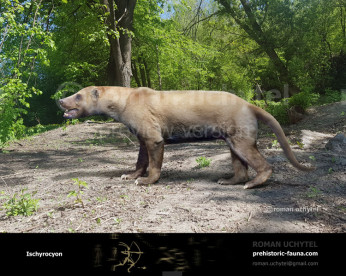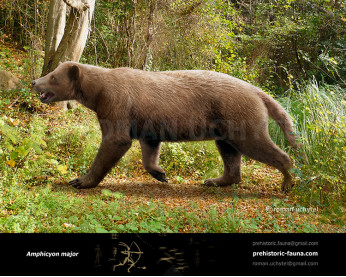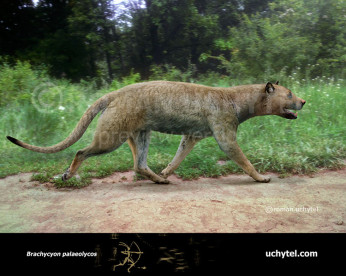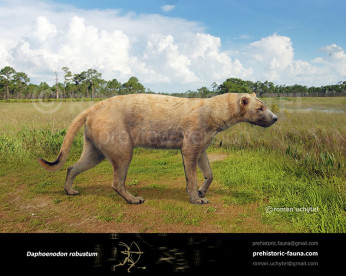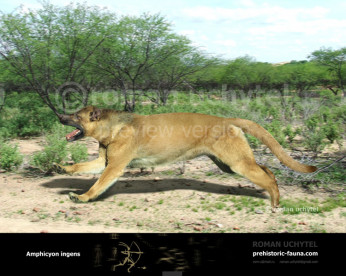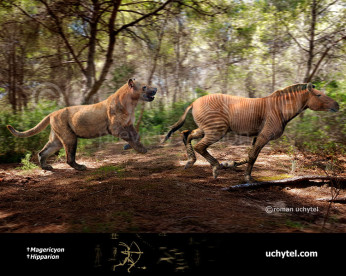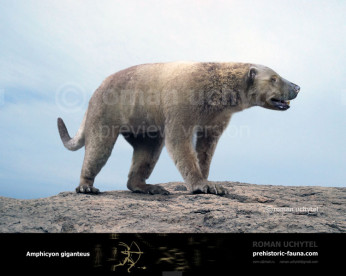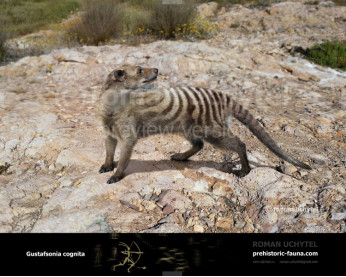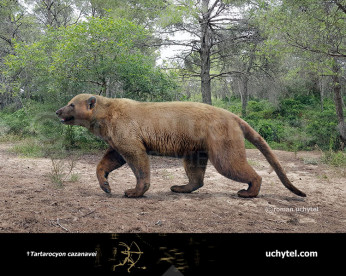Ammitocyon
1000000009410000000094Ammitocyon (†Ammitocyon kainos (Morales et al., 2021))
Thaumastocyon
Class: Mammalia
Order: Carnivora
Suborder: Caniformia
Family: †Amphicyonidae
Subfamily: †Thaumastocyoninae
Time period: the Late Miocene of Europe (Spain, 9.1 Ma)
Size: Up to 2.5 meters long. 1,1 meters tall at the shoulder. Weight estimated at up to 250 kg.
Ammitocyon is a genus of large sized bear dogs, belonging to the Amphicyonidae, that lived during the Late Miocene in what is now Spain. It is notable for its extreme adaptations towards hypercarnivory, its extremely robust skeleton, and was one of the last surviving members of its family.
Ammitocyon was a lion-sized taxon, with its weight estimated at 231 kg. It is characterized by its extremely robust build, with powerful legs, almost unmatched among caniforms, and adaptations to hypercarnivory. Its chin and muzzle are sturdy, and its snout is huge, with a wide nasal aperture. The dentition is sectorial. This animal possess many traits that can be found in other carnivorans, but their association with each other is exclusive to this genus. Its chewing apparatus is completely unique, with no equivalent existing among other hypercarnivores.
The paleoenvironment has been reconstructed as woodland, with patches of grassland. Ammitocyon shared this habitat with several other large carnivorans, each of them surpassing 100 kg in weight - the somewhat smaller bear dog Magericyon anceps, the ursid Indarctos arctoides, and the lion-sized saber-toothed cat Machairodus aphanistus. The carnivoran assemblage was further enriched by the leopard-sized Promegantereon ogygia, the mustelid Eomellivora piveteaui, comparable to a brown hyaena in size, as well as the smaller felid Leptofelis vallesiensis, the hyaena Protictitherium crassum, the mephitid Promephitis, and a number of smaller mustelids. The most common large herbivore is the equid Hipparion, although the suid Microstonyx, the moschid Micromeryx, the antelope Austroportax, and another unidentified bovid, as well as indeterminate rhinoceros remains have also been found.
Among the very large carnivorans, Ammitocyon most frequently preyed on Hipparion in wooded areas.
Payment
You may use multiple payment methods to buy image such as credit cards, PayPal and bank transfer.
Ammitocyon (†Ammitocyon kainos (Morales et al., 2021))
Thaumastocyon
Class: Mammalia
Order: Carnivora
Suborder: Caniformia
Family: †Amphicyonidae
Subfamily: †Thaumastocyoninae
Time period: the Late Miocene of Europe (Spain, 9.1 Ma)
Size: Up to 2.5 meters long. 1,1 meters tall at the shoulder. Weight estimated at up to 250 kg.
Ammitocyon is a genus of large sized bear dogs, belonging to the Amphicyonidae, that lived during the Late Miocene in what is now Spain. It is notable for its extreme adaptations towards hypercarnivory, its extremely robust skeleton, and was one of the last surviving members of its family.
Ammitocyon was a lion-sized taxon, with its weight estimated at 231 kg. It is characterized by its extremely robust build, with powerful legs, almost unmatched among caniforms, and adaptations to hypercarnivory. Its chin and muzzle are sturdy, and its snout is huge, with a wide nasal aperture. The dentition is sectorial. This animal possess many traits that can be found in other carnivorans, but their association with each other is exclusive to this genus. Its chewing apparatus is completely unique, with no equivalent existing among other hypercarnivores.
The paleoenvironment has been reconstructed as woodland, with patches of grassland. Ammitocyon shared this habitat with several other large carnivorans, each of them surpassing 100 kg in weight - the somewhat smaller bear dog Magericyon anceps, the ursid Indarctos arctoides, and the lion-sized saber-toothed cat Machairodus aphanistus. The carnivoran assemblage was further enriched by the leopard-sized Promegantereon ogygia, the mustelid Eomellivora piveteaui, comparable to a brown hyaena in size, as well as the smaller felid Leptofelis vallesiensis, the hyaena Protictitherium crassum, the mephitid Promephitis, and a number of smaller mustelids. The most common large herbivore is the equid Hipparion, although the suid Microstonyx, the moschid Micromeryx, the antelope Austroportax, and another unidentified bovid, as well as indeterminate rhinoceros remains have also been found.
Among the very large carnivorans, Ammitocyon most frequently preyed on Hipparion in wooded areas.

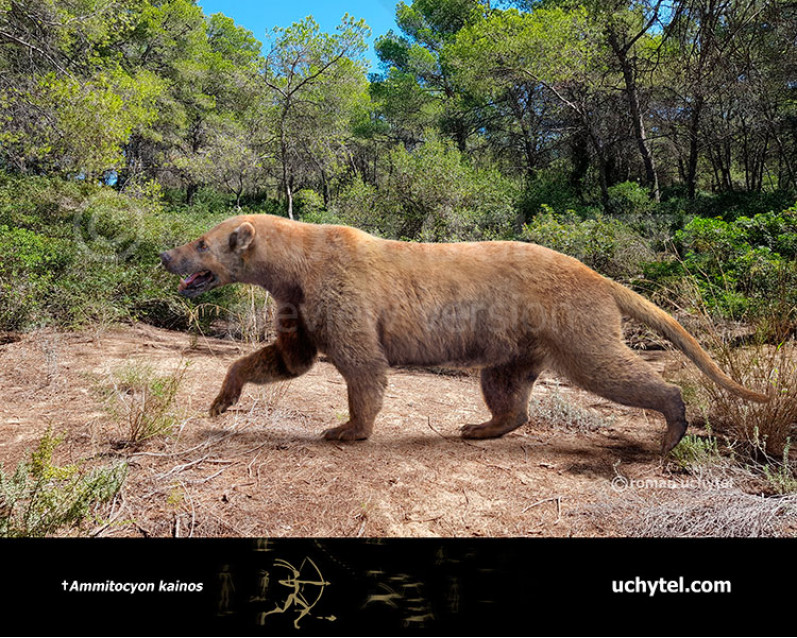
1-797x638.jpg)
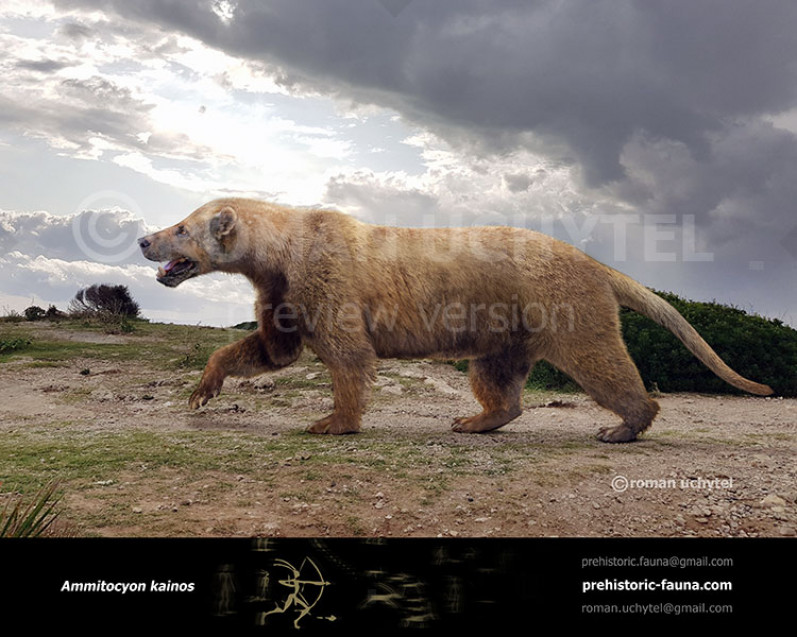

1-70x56.jpg)

